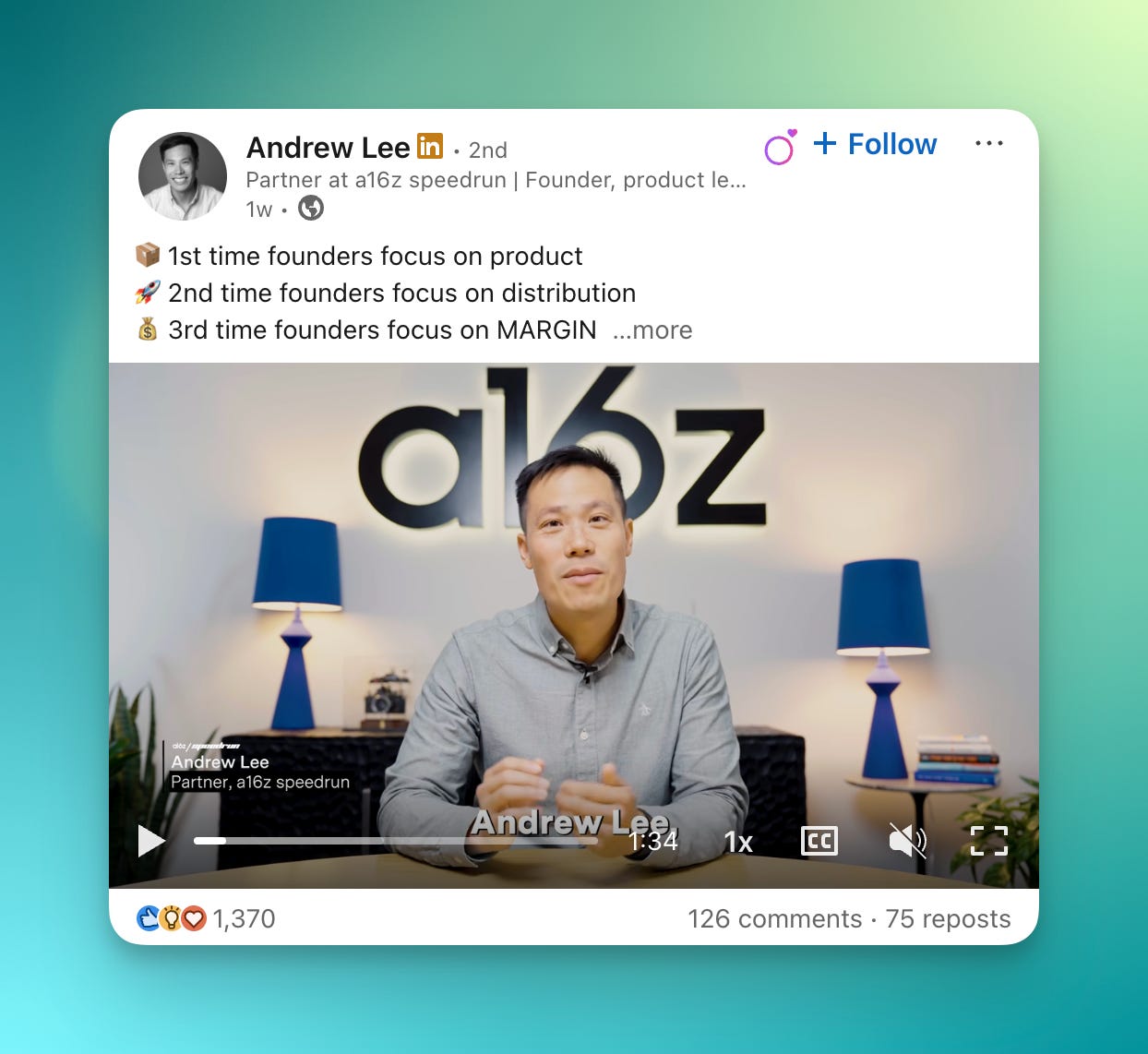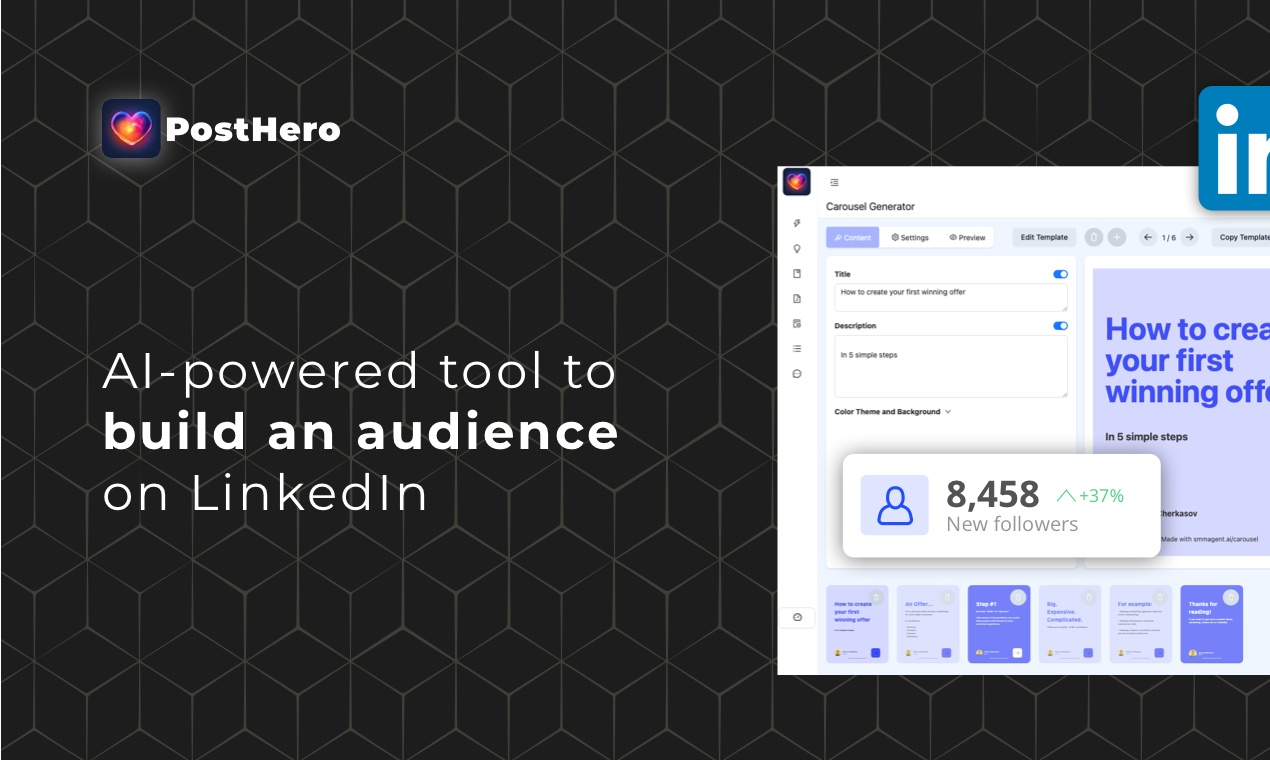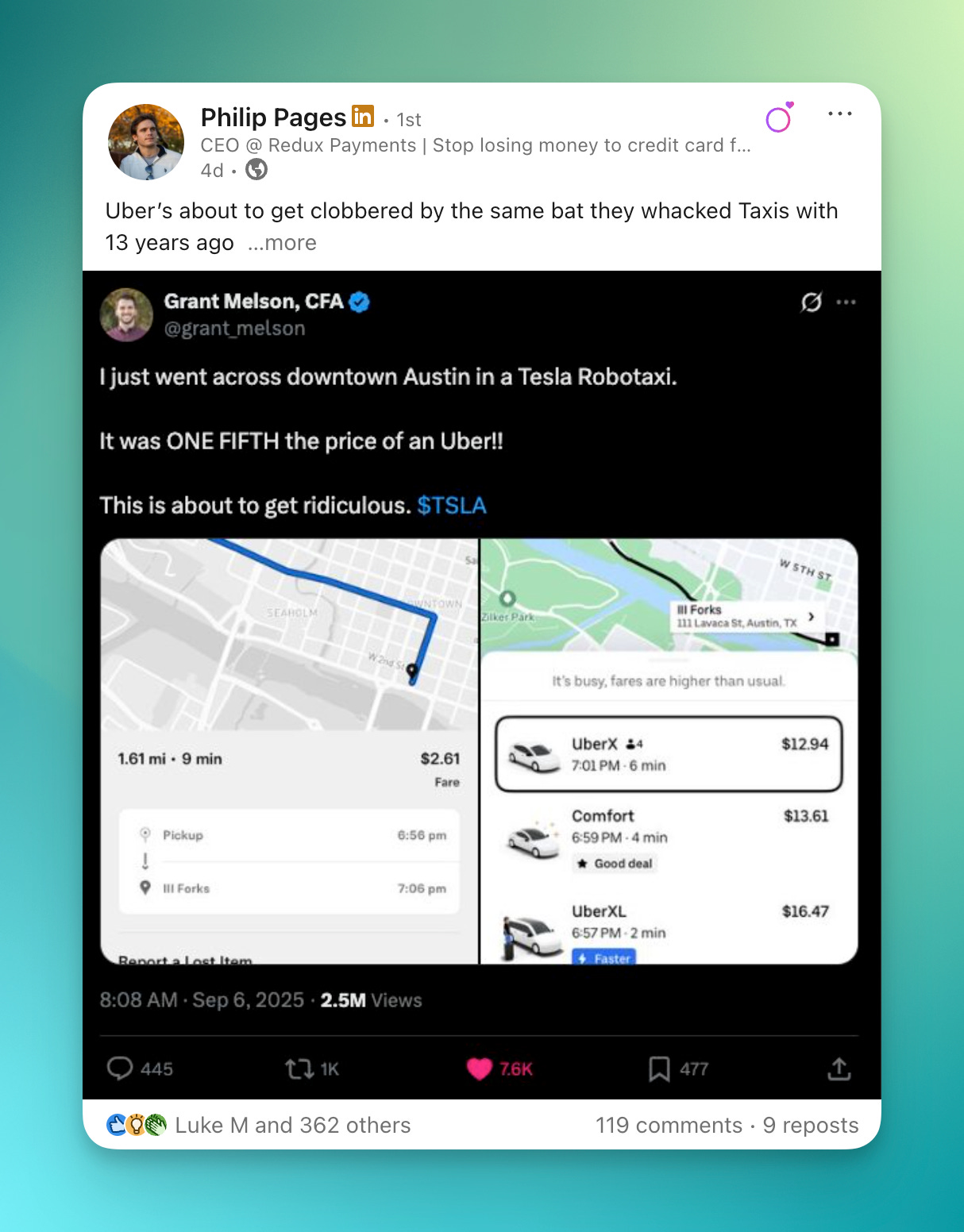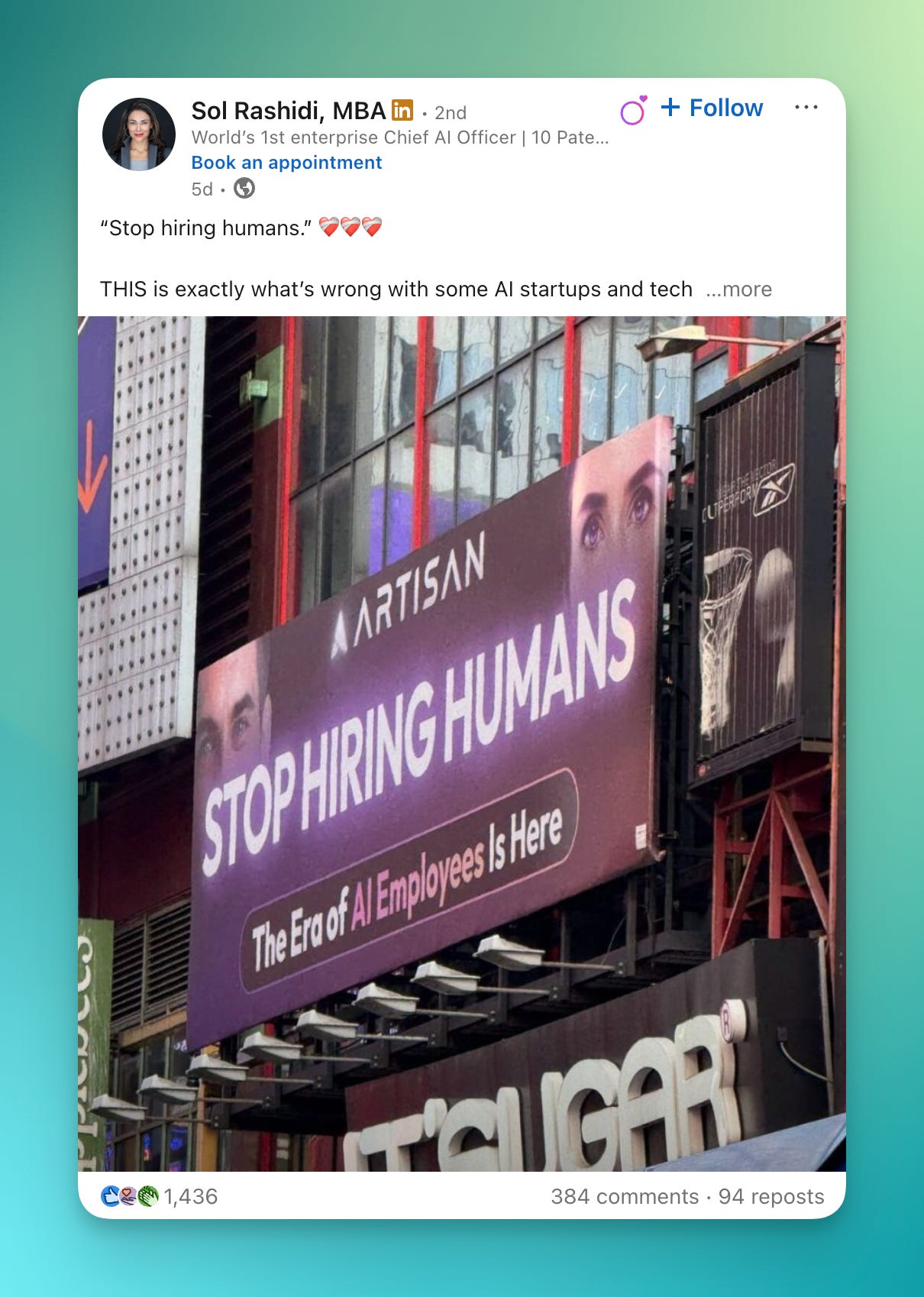LS #61: How to Fix LinkedIn Content That Doesn’t Convert
Your LinkedIn content gets likes. Gets comments. Gets shares. But your calendar stays empty.
Hi there,
I analyze top LinkedIn posts to teach you how to write content that connects.
In this issue, you’ll find:
The 3 high-performing LinkedIn posts this week
How to Fix LinkedIn Content That Doesn’t Convert
The 3 high-performing posts this week
1. 1st time founders focus on product
Why this post?
This post went viral, receiving almost 1.3k likes in a week. It received 37-57 more engagement and views than Andrew’s posts this week.
WHY THIS POST WENT VIRAL
This post gave founders a clear roadmap for how their thinking should evolve across multiple ventures. The three-stage framework was simple enough to remember but deep enough to be useful, and backing it up with real examples (gaming startup, FarmVille) made it credible. The surprising insight that first and third-time founders both focus on product (just differently) challenged conventional wisdom. Connecting it to the current AI wave made it feel timely and urgent.
BREAKDOWN
Simple pattern framework: Three emoji bullets showing founder evolution stages - easy to scan and remember
Personal experience: “I learned this first-hand with our gaming startup” - proves he lived through this
Counter-example stories: Uses FarmVille as real-world example of distribution gone wrong
Competitive insight: “Your product must be 10x better, or you lose margin to rivals” - sets clear bar
Surprising twist: Reveals 1st and 3rd time founders actually focus on same thing (product → margin connection)
AI opportunity framing: Connects lesson to current wave - “once-in-a-generation chance to rebuild enterprise”
HOW TO CREATE YOUR OWN POST:
Create a progression framework: Show how thinking evolves through different stages or attempts
Use yourself as proof: Share specific examples from your own journey through these stages
Include cautionary tales: Use well-known company examples to show what happens when you ignore the lesson
Break down complexity: Take hard concepts and split them into 3-5 simple components
Set clear standards: Give specific benchmarks like “10x better” that people can measure against
POST IDEAS FOLLOWING THIS TEMPLATE:
“1st time CEOs focus on vision, 2nd time CEOs focus on execution, 3rd time CEOs focus on culture”
“Early-stage startups optimize for speed, growth-stage for efficiency, mature-stage for durability”
“Junior developers focus on code, senior developers focus on systems, staff engineers focus on people”
“New managers focus on tasks, experienced managers focus on teams, executives focus on incentives”
“First-time investors chase returns, second-time chase deals, third-time chase relationships”
TOGETHER WITH POSTHERO
Grow your audience faster on LinkedIn. With an AI-powered tool that helps you create content and grow on LinkedIn.
Create high-converting content that helps you grow on LinkedIn
Create a weekly content in 76 seconds
AI Voice assistant for creating content in seconds
2. Uber’s about to get clobbered by the same bat they whacked Taxis with 13 years ago
Why this post?
Another post that went viral this week—it got 1k likes in 11 hours and performed 11-40 times better than Philip’s other posts this week.
WHY THIS POST WENT VIRAL
This post captured a major industry disruption happening in real-time with clear visual proof. The irony of Uber getting disrupted the same way they disrupted taxis was too perfect to ignore. The side-by-side price comparison ($2.61 vs $12.94) made the threat undeniable and shareable. Philip showed deep industry knowledge by analyzing Uber’s entire history and competitive position, then laid out multiple strategic scenarios that got industry experts debating in the comments.
BREAKDOWN:
Attention-grabbing hook: “Uber’s about to get clobbered by the same bat they whacked Taxis with“ - creates instant drama
Historical parallel: References how Uber disrupted taxis 13 years ago to set up the irony
Viral tweet screenshot: Uses Grant Melson’s Tesla Robotaxi experience showing 1/5th the price of Uber
Visual price comparison: Side-by-side screenshots ($2.61 vs $12.94) make the threat impossible to ignore
Detailed analysis: Breaks down the entire history from Uber’s early days to current Robotaxi threat
Multiple strategic scenarios: Lists several possible responses Uber could take with questions for each
Competitive dynamics: Explains why Tesla owns everything (vehicle, software, brand, distribution)
HOW TO CREATE YOUR OWN POST:
Start with bold disruption claim: Predict a major industry shift that seems inevitable
Use historical irony: Show how the disruptor is about to become the disrupted
Include viral evidence: Screenshot or embed content that’s already getting traction
Tell the full story: Don’t just make the claim - explain the entire evolution
Map out scenarios: Show multiple possible futures instead of just one prediction
3. “Stop hiring humans.” ❤️🩹❤️🩹❤️🩹
Why this post?
This post performed 4-12 times better than Sol’s other posts this week.
WHY THIS POST WENT VIRAL
This post tapped into widespread anxiety about AI replacing jobs by showing actual evidence of companies openly bragging about it. The Times Square billboard made it impossible to dismiss as hypothetical - this was real and public. The emotional framing about telling kids their future jobs won’t exist made the abstract threat feel personal and urgent.
BREAKDOWN:
Provocative quote hook: “Stop hiring humans“ with heartbreak emojis - immediately emotional and controversial
Clear villain identified: Names Artisan and shows their actual billboard to prove it’s real
Photo evidence: Large billboard in Times Square makes the threat feel massive and public
Emotional framing: “On the surface, these moves sound bold. In reality, they’re so so so dangerous”
Future scenario storytelling: Paints picture of telling 12-year-old their future jobs may not exist
Reframing the solution: “AI shouldn’t replace. It should reallocate, elevate, and evolve us”
HOW TO CREATE YOUR OWN POST:
Lead with shocking quote: Use the actual language from the thing you’re criticizing
Name specific villains: Don’t be vague - call out actual companies and show proof
Use photo evidence: Screenshots or photos that make the problem undeniable
Add multiple examples: Show this isn’t isolated - it’s a dangerous pattern
Contrast perception vs reality: “Sounds bold but actually dangerous” structure works well
LinkedIn Guide
How to Fix LinkedIn Content That Doesn’t Convert
Your LinkedIn content gets likes. Gets comments. Gets shares.
But your calendar stays empty. Your DMs are quiet. Your revenue doesn’t move.
I see this every week: Founders with great engagement numbers but zero business results.
Here’s the brutal truth: Most LinkedIn content is entertainment, not conversion.
The Conversion Problem
What most founders experience:
Post gets 20+ likes
3+ comments saying “great insight!”
Decent profile views
But zero demos booked, zero leads generated, zero revenue
Why this happens:
Content attracts the wrong audience
No clear path from engagement to conversation
Posts designed for likes, not business outcomes
The reality: If your LinkedIn isn’t generating business results, you’re running a popularity contest, not a business.
The 5 Conversion Killers (And How to Fix Them)
Conversion Killer #1: You’re Creating Content for Creators
The problem: Your posts attract other marketers and founders who love to engage but will never buy.
Example of creator-focused content: “5 productivity hacks that changed my life:
Wake up at 5 AM
Morning meditation
Time blocking...”
Who engages: Other productivity enthusiasts
Who doesn’t engage: Your actual buyers
The Fix: The Buyer-Only Content Filter
Before posting, ask:
Would my ideal customer care about this?
Does this relate to a problem they’re actively trying to solve?
Does this demonstrate capability they’d pay for?
Example of buyer-focused content: “How we reduced our support ticket volume by 65% in 90 days:”
Why this converts: Attracts founders with support/scaling problems and demonstrates specific problem-solving capability.
Conversion Killer #2: No Clear Next Step
The problem: People engage with your content but have no idea what to do next.
The Fix: The Conversion Path System
Every piece of content needs one of these:
Path 1: The Question Close “What’s your biggest challenge with [problem]?”
Path 2: The Lead Magnet Offer “I created a framework for [solving problem]. DM me ‘FRAMEWORK’ and I’ll send it over.”
Path 3: The Case Study Tease “Happy to share the full breakdown of how we did this if anyone’s interested.”
Path 4: The Diagnostic Question “If you’re seeing [specific symptom], you might have [problem]. We built a free assessment - DM me for the link.”
Conversion Killer #3: You’re Teaching Instead of Teasing
The problem: You give away so much value that people don’t need to talk to you.
Example of over-teaching: Complete 10-step process with every detail, template, and formula included.
Why this kills conversion: They now have everything they need. No reason to reach out.
The Fix: The Give-Get Balance
The 70-30 Content Split:
70% of the value: Share the what and why
30% held back: Keep the how and implementation details
Example of proper teasing: “How we reduced churn from 18% to 6% in 90 days:
The breakthrough: 80% of churn happened because customers never activated our core feature.
The fix had 3 parts:
Behavioral triggers that identified stuck users
Automated intervention at friction points
Personalized success paths by user segment
Result: Activation rate 45% → 82%. Churn dropped to 6%.
The most interesting part was how we identified which specific moments to intervene. It wasn’t obvious until we mapped the entire user journey.
Happy to share more about the methodology if anyone’s dealing with activation challenges.”
Why this converts: Shares enough to demonstrate expertise, creates curiosity, leaves room for conversation.
Conversion Killer #4: Generic Problem, Generic Solution
The problem: Content so broad that nobody feels it’s specifically for them.
Example of generic content: “Customer retention is important. Here’s how to improve it:
Listen to customer feedback
Provide great support
Add more value”
The Fix: The Hyper-Specific Problem Framework
The Specificity Formula:
Narrow the audience (SaaS founders, not all businesses)
Specify the stage (Series A, not all startups)
Name the exact problem (churn in months 2-3, not general retention)
Show specific numbers (from 18% to 6%, not “improved”)
Conversion Killer #5: No Trust-Building Mechanism
The problem: Asking people to reach out without giving them a reason to trust you first.
The Fix: The Authority Stack System
Build trust systematically:
Week 1-2: Show you understand their problems deeply
Week 3-4: Share frameworks that demonstrate expertise
Week 5-6: Show specific outcomes and case studies
Week 7-8: Share predictions and forward-thinking insights
Then repeat the cycle.
The Content Conversion Audit
Ask yourself about your last 10 posts:
Did they attract your ideal buyers or just other creators?
Was there a clear next step for interested prospects?
Did you give away too much or tease appropriately?
Could your ideal customer recognize themselves immediately?
Did you demonstrate expertise and credibility?
If you answered “no” to 3 or more, your content isn’t designed to convert.
Content Conversion Metrics That Matter
Stop tracking:
Likes per post
Comments per post
Follower growth
Start tracking:
DMs from qualified prospects
Demo requests from content
Revenue attributed to LinkedIn content
The Content Conversion Formula
Buyer-Focused Topics (solve their problems) + Clear Next Steps (make it easy to engage) + Strategic Withholding (tease, don’t teach everything) + Hyper-Specificity (they should feel seen) + Trust Building (demonstrate expertise over time) = Content that converts
Stop optimizing for likes. Start optimizing for revenue.
That’s a wrap for today.
See you next week! If you want more LinkedIn tips, be sure to follow me on LinkedIn (link).
If you love this episode and want to support us, spread the word about us by sharing The LinkedIn Secrets with colleagues. I really appreciate it!
Thank you for reading!
What’d you think of today’s edition?
Help me to understand what you think about this episode. Just reply with a number (1, 2, or 3) to this email.
1 - Damn good
2 - Meh, do better
3 - You didn’t cook it
Your compadre,
Anton “LinkedIn growth strategies” Cherkasov





